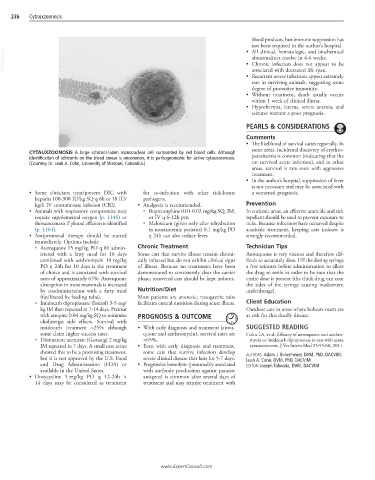Page 528 - Cote clinical veterinary advisor dogs and cats 4th
P. 528
236 Cytauxzoonosis
blood products, but immune suppression has
not been required in the author’s hospital.
VetBooks.ir • Chronic infection does not appear to be
• All clinical, hematologic, and biochemical
abnormalities resolve in 4-6 weeks.
associated with decreased life span.
• Recurrent severe infections appear extremely
rare in surviving animals, suggesting some
degree of protective immunity.
• Without treatment, death usually occurs
within 1 week of clinical illness.
• Hypothermia, icterus, severe anemia, and
seizures warrant a poor prognosis.
PEARLS & CONSIDERATIONS
Comments
• The likelihood of survival varies regionally. In
some areas, incidental discovery of erythro-
CYTAUXZOONOSIS A large schizont-laden mononuclear cell surrounded by red blood cells. Although
identification of schizonts on the blood smear is uncommon, it is pathognomonic for active cytauxzoonosis. parasitemia is common (indicating that the
(Courtesy Dr. Leah A. Cohn, University of Missouri, Columbia.) cat survived acute infection), and in other
areas, survival is rare even with aggressive
treatment.
• In the author’s hospital, suppression of fever
is not necessary and may be associated with
• Some clinicians treat/prevent DIC with for co-infection with other tick-borne a worsened prognosis.
heparin 100-300 IU/kg SQ q 8h or 18 IU/ pathogens.
kg/h IV constant-rate infusion (CRI). • Analgesia is recommended. Prevention
• Animals with respiratory compromise may ○ Buprenorphine 0.01-0.02 mg/kg SQ, IM, In endemic areas, an effective acaricide and tick
require supplemental oxygen (p. 1146) or or IV q 6-12h prn repellent should be used to prevent exposure to
thoracocentesis if pleural effusion is identified ○ Meloxicam (given only after rehydration ticks. Because infections have occurred despite
(p. 1164). in nonazotemic patients) 0.1 mg/kg PO acaricide treatment, keeping cats indoors is
• Antiprotozoal therapy should be started q 24h can also reduce fever. strongly recommended.
immediately. Options include
○ Atovaquone 15 mg/kg PO q 8h admin- Chronic Treatment Technician Tips
istered with a fatty meal for 10 days Some cats that survive illness remain chroni- Atovaquone is very viscous and therefore dif-
combined with azithromycin 10 mg/kg cally infected but do not exhibit clinical signs ficult to accurately dose. Fill the dosing syringe
PO q 24h for 10 days is the treatment of illness. Because no treatments have been a few minutes before administration to allow
of choice and is associated with survival demonstrated to consistently clear the carrier the drug to settle in order to be sure that the
rates of approximately 65%. Atovaquone phase, recovered cats should be kept indoors. entire dose is present (the thick drug can coat
absorption in most mammals is increased the sides of the syringe causing inadvertent
by coadministration with a fatty meal Nutrition/Diet underdosage).
(facilitated by feeding tube). Most patients are anorexic; nasogastric tube
○ Imidocarb dipropionate (Imizol) 3-5 mg/ facilitates enteral nutrition during acute illness. Client Education
kg IM then repeated in 7-14 days. Pretreat Outdoor cats in areas where bobcats roam are
with atropine 0.04 mg/kg SQ to minimize PROGNOSIS & OUTCOME at risk for this deadly disease.
cholinergic side effects. Survival with
imidocarb treatment ≈25% although • With early diagnosis and treatment (atova- SUGGESTED READING
some claim higher success rates. quone and azithromycin), survival rates are Cohn LA, et al: Efficacy of atovaquone and azithro-
○ Diminazene aceturate (Ganaseg) 2 mg/kg ≈65%. mycin or imidocarb dipropionate in cats with acute
IM repeated in 7 days. A small case series • Even with early diagnosis and treatment, cytauxzoonosis. J Vet Intern Med 25:55-60, 2011.
showed this to be a promising treatment, some cats that survive infection develop AUTHORS: Adam J. Birkenheuer, DVM, PhD, DACVIM;
but it is not approved by the U.S. Food severe clinical disease that lasts for 5-7 days. Leah A. Cohn, DVM, PhD, DACVIM
and Drug Administration (FDA) or • Progressive hemolysis (presumably associated EDITOR: Joseph Taboada, DVM, DACVIM
available in the United States. with antibody production against parasite
• Doxycycline 5 mg/kg PO q 12-24h × antigens) is common after several days of
14 days may be considered as treatment treatment and may require treatment with
www.ExpertConsult.com

